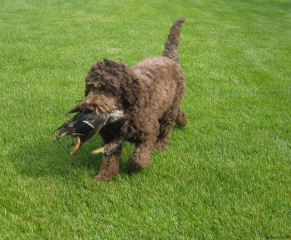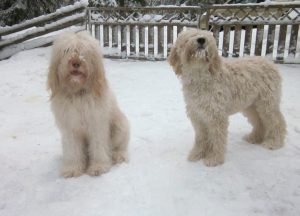The Barbet is a rare breed. Most Barbet, especially those shown in conformation shows, are entirely black, black and white, or brown. It is common to see white chest spots and white paws or legs on black or brown coated dogs. Parti, Creme, and Pied variations are being born but in very limited numbers.
Male Barbet usually grow to be about 21-25 inches (52 cm to 65 cm) tall, and they weigh between 40 and 60 pounds (18 kg to 27 kg), while the females usually grow to be about 20 to 23 inches (50 cm to 53 cm) tall, and they weigh between 30 and 50 pounds (13.5 kg to 23 kg).
Appearance
Table of Contents
The breed stands 58 to 65 cms (20.5-25.5 inches) for the males in height, 52 to 61 for the females with a tolerance of 1 cm +/- and weighs 17 to 28 kg (35-60 pounds). The Barbet is a prototypic water dog, with a long, woolly, and curly coat. Their coats grow long and must be groomed regularly, otherwise the coat can become matted and the barbet may lose small tufts of hair like tumbleweeds.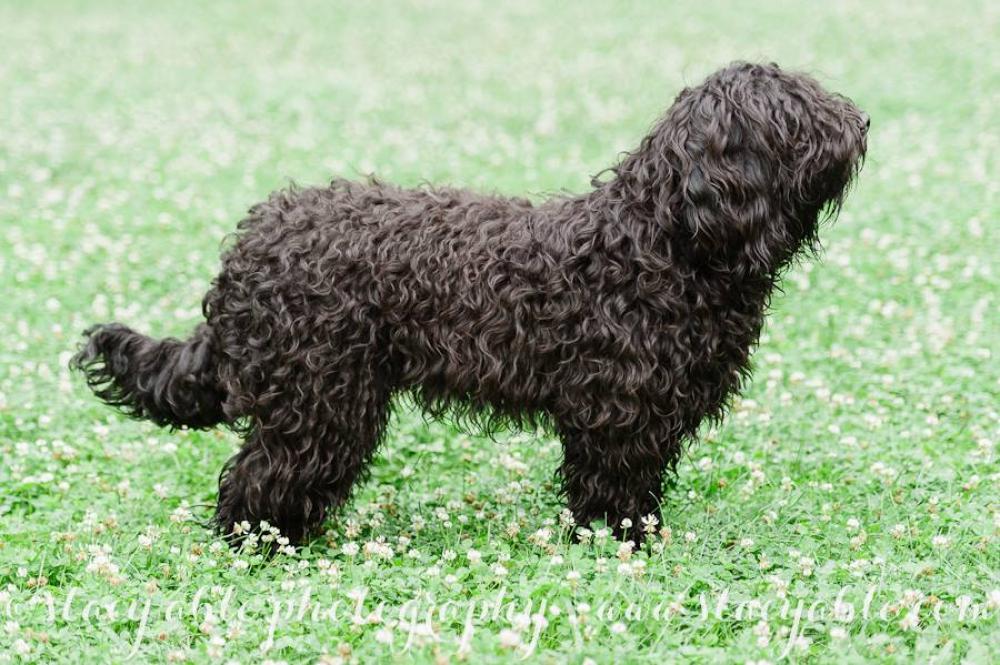
The accepted colours of the breed are solid black, brown, fawn, grey, pale fawn, white, or more or less pied. All shades of red-fawn and pale fawn are permitted. The shade should, preferably, be the same as the colour of the body. Grey and white are extremely rare; mixed colours (except with white) are considered as a fault. The most common colors are black or brown with white markings. The birth figures worldwide for 2007 are 176. All born were black or brown some with white markings on the chest, chin, and legs.
Temperament
The Barbet’s personality is described as companionable, joyful, goofy, obedient, and intelligent. They are quick to learn and need lifelong obedience training. They are a great with children, families, and the elderly. Barbet will bond with their family and prefer to be in the same room with the family at all times. They need exercise daily to keep the dog in a healthy state of mind and body.
They are capable retrievers for waterfowl hunting. In France the Barbet can take the Test d`Aptitude Naturelle (T.A.N.) a basic water retrieving test and has recently been permitted to participate in the BCE. (Brevet de Chasse a l’Eau) which is a general hunting test involving field and water trials. In Germany the Barbet takes part in field trials.
Overall Health
Due to the extremely low number of Barbet in the world, little is known about long term health issues. Some issues that have exhibited themselves are ear infections, hip dysplasia, hernias, undescended testicles, undershot/overshot bites, and epilepsy. However, a study has just begun in France about health issues in the Barbet as several breeds have recently “contributed” to the Barbet. Most breeders today hipscore the parents before any matings and A, B, and C hipscores can be used.
The most common of these issues are ear infections, a problem in most water dog varieties. Ear problems can be minimized by proper ear care. A veterinarian should be consulted if the dog shows signs of an ear infection.The ear should always be clear of any hair, and inspected very regularly.
Lifespan
Lifespan of the Barbet averages 13–15 years with one recorded passing away at age 19.
History
The Barbet breed is an integral part of dog history, and many familiar breeds have Barbet in their ancestry. Depending on geography and necessity, the Barbet connected through the centuries in various capacities, and as a companion dog, but more as an all-around working dog. The name Barbet became throughout centuries a “generic” name for a dog with a long, curly, woolly coat.[2]
The `Grand Barbet` depicted in Count George Louis Buffon’s book `Histoire Naturelle’ (1750) is thought to be the original source of the various water dog breeds (Poodle, Portuguese Water Dog, American Water Spaniel, and so on). However Grand Barbet never existed as a breed. Its actual origin is lost in antiquity but probably stems from corded herding stock.
The Barbet is a French water dog and the breed’s name “Barbet” comes from the French word barbe, which means beard. It was best known for being a waterfowl retriever in the marshes, wetlands and estuaries of France which is where the expression “muddy as a barbet” came from in the 19th century. Between the late 18th to early 19th century the same dog was known as the barbet in France, the barbone in Italy, and the pudel in Germany. With the advent of dog shows and selective breeding based purely on aesthetics the poodle was developed to be more elegant and of a solid colour to distinguish it from its more common past. The versatile nature of the Barbet has meant its survival, and many of today’s Barbet still have the assets attributed to them from the past and the Barbet origins and bloodlines can be traced back to the writing of the first standard in 1886. More about history can be found here.
If You want to know more about the breed’s history visit the historical references section
Care & Grooming
There are conflicting ideas on how to groom this breed. Some say they should be brushed regularly with regular trimming, and others believe their coat should be allowed to grow naturally and allowed to form into a thick woolly and/or corded coat. The coat will get matted/felted easily and should carefully be pulled apart without tearing the coat.
If the coat is kept trimmed to approximately 10 cm all over the body and slightly longer on the head, it will be easier to maintain and look neat. Hair on the ears, chin and tail should be trimmed less often than the rest of the body. The hairs from the ear canal should be gently plucked out regularly. Some coats matt more easily than others. Left unattended, the Barbet hair will grow to extensive lengths. The hair in between and around their eyes can be periodically clipped for cleaner eyes.
If the coat is shown in a rustic style there should be no fluffing or blowing out. The coat should match the lines of the dog and the curls should be evident. The dog should have the appearance of the working dog that it is. If clipped down shorter than 10 cm, the coat will need about 3 months of growth to be ready to show. Long or short, natural or brushed, make no mistake – a rustic dog with a rustic coat does not mean unkempt or dirty.
As the stories go, traditionally, farmers would shear their Barbet in the spring along with their sheep. There are some Barbet coats today who have coat textures that manage well with this tradition.
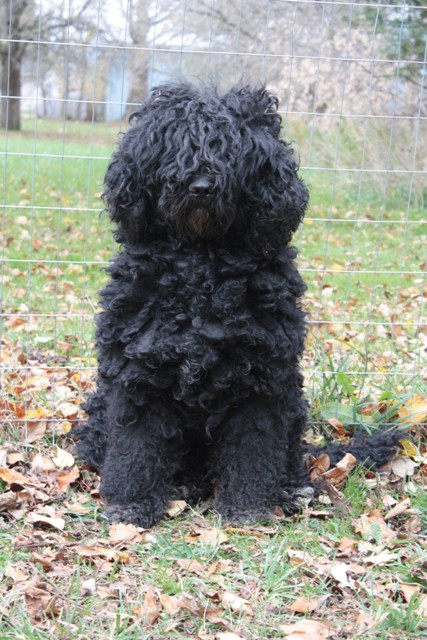
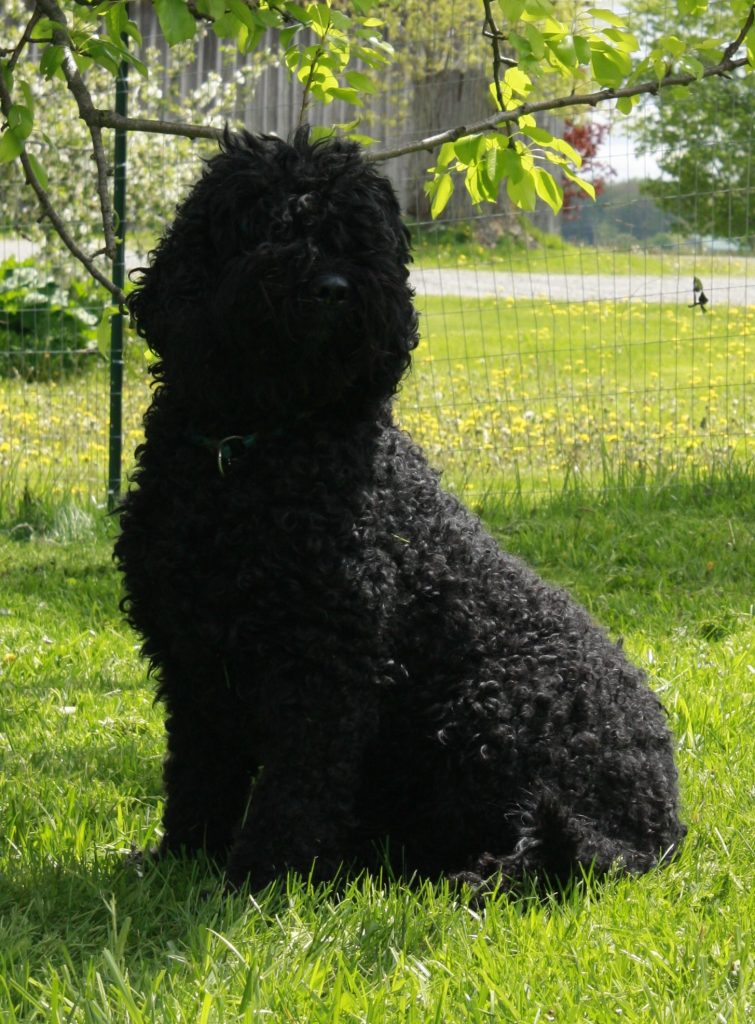
Rus·tic
Variant(s): also rus·ti·cal \-ti-kəl\
Pronunciation: \ˈrəs-tik\
Function: adjective
Etymology: Middle English rustik, from Latin rusticus, from rus open land — more at room
Date: 15th century
1: of, relating to, or suitable for the country : rural; rustic rolling farmland; 2a : made of the rough limbs of trees; rustic furniture; b : finished by rusticating; a rustic joint in masonry; 3a : characteristic of or resembling country people b : lacking in social graces or polish 4 : appropriate to the country (as in plainness or sturdiness); heavy rustic boots; — rus·ti·cal·ly\-ti-k(ə-)lē\ adverb — rus·tic·i·ty\ˌrəs-ˈti-sə-tē\ noun
The Barbet whether in rustic coat or show groomed coat should have the same body, structure and morphology underneath all that hair. This is an old measurement document used by breeders for years.
The following has been generously shared by Mrs. Greet Los-Romeijn of the Netherlands, she and her husband Alex breed Barbet and Lagotto, as well, Greet is a professional groomer.
GROOMING ~ A Groomer’s perspective:
The brushing and dematting is a big job, especially for hair that long.
Hopefully, your dog will learn to enjoy the time you spend together on the grooming table, and I guarantee that you will learn all about the Barbet HANDS ON during this time!
To start:
Brush and comb the dog carefully. All matts should be removed.
Wash the dog and dry the dog with a blower (this should be done at least 2 weeks prior to a confirmation show, otherwise the coat may feel too soft)
Before grooming starts, have a copy of the Barbet standard close by!
Body: Cut the whole body evenly from shoulders to croupe, using clippers or scissors or a combination of both.
Back: straight with rounded hips and a nice tail set
Back-legs: nice angulations, low hocks and rounded big feet.
Fore-legs: straight, also with big round feet, with good angulation to the fore chest.
Under chest: hair to the elbows.
Tail: when the tail is to thick – remove on the top side of the tail. Leave the underside natural but not too long.
Head: don’t cut the hair too short. The hair should not be puffed up and high on the head. The forelock should fall upon the bridge of the nose. If you wish, you can remove some of the bulky hair from eye-corner to eye-corner.
Neck: Cut evenly from ears to neck. Cut down to shoulders and create a nice even top line.
Throat: Cut short from throat to fore chest. Leave the fore chest to the forelegs longer to pronounce the fore chest.
Leave ears and beard long. When the hair on the cheeks (under the ears) is too thick you can thin it out with thinning-shears.
Once you have gone over the dog again to ensure an even cut and good representation of the angles/characteristics, wet the dog all over, and let him dry out naturally.
Then the natural and rustic (but clean and matt free) look of the Barbet has been achieved and maintained.
Coat Types/Textures
The Barbet hair has some diversity in regards to type and texture of coat. While the general appearance is more or less curly, some coats texture can vary. Frizzy, dense and thick or wavy, thin and soft.
© Greet Los-Romeijn 2010 Groomer
Eyes: Dogs have three eyelids. They have an upper and lower eyelid and a third one inside of the other two. It helps protect the eye from dirt and dust. It is also called a “haw”. 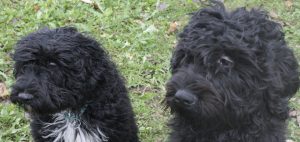
With the dense hair around the Barbet eyes, it is necessary to clean the crusted discharge from the corners of the eyes. Simply by putting your finger at the tear duct and wiping away the “eye booger” or using a tissue and wiping away the moist one. The more hair on or around the eyes, the more the eye collects. Just think to do this when you are petting the dog, it becomes second nature, and the dog gets used to it.
Ears: Dogs ears are different from ours. The canal is much longer and makes a 45 degree turn towards the jaw. These differences make seeing into the ear more difficult. Dogs who spend time swimming and in water have protective hair and waxy build up in their ears to prevent water retention and damage. Generally, the Barbet has quite hairy ear canals.
Weekly their ears should be checked. If they give off a sweet and “yeasty” pungent odour, it’s definitely time to clean them!!! Yellow to yellowish brown is normal, even black waxy discharge. If you notice excessive scratching or some whimpering when scratching … that can mean an ear infection.
There are many good ear products on the market, or you can make your own ear preparation. Liquid ear cleaner is generally a water/witch hazel/lavender oil combination. This is great to squirt down the canal and rub around. Leave for a short while and then wipe out with a tissue The liquid helps work the deep down wax build up – out to the outer ear. It smells great too.
Powder cleaner is also effective. Again, you can buy prepared products or use/make your own. Astringent and anti-humectant preparations are best such as Boric Acid or Iodoform. Shake or squeeze some into the ear, leave it for a few minutes and then start “plucking”. You can use your fingers and when using the ear powders you can get a good grip on the hair. You can also use a hemostat (surgical clamp) especially if you use ear solutions, as it’s harder to get a good hold on the wet hair to pull out. If you have never done ear maintenance before, you may want to get your vet or groomer to show you a good technique and how far to pluck.
To make your own ear powder:
4 oz. zinc oxide powder
4 oz. boric acid powder
½ oz iodoform powder.
Mix well. Keep in a sealed jar in a cool, dry place.
To make your own ear liquid:
12 oz rubbing alcohol
4 tablespoons boric acid
16 drops gentian violet.
Shake well before using. Keep in a squeeze bottle and be careful when using, the gentian violet STAINS.
Witch hazel is always good for superficial cleaning as well (on a cotton ball) because it doesn’t dry out like ear skin like alcohol.
In either case, liquid or powder, your dog may squirm, fight and cry the first few times. Be persistent!!! The only way to keep away ear issues is good ear maintenance.
Barbet – owner’s perspective
FCI-Standard N° 105 / 29. 03. 2006 /GB FRENCH WATER DOG (Barbet)
TRANSLATION: Jennifer Mulholland.
ORIGIN: France
DATE OF PUBLICATION OF ORIGINAL VALID STANDARD: 21.02.2006.
UTILIZATION: Water dog used for hunting wildfowl. Like all water dogs, the French Water Dog is more than just a retriever; he must search for, locate and flush out the game hiding in the water vegetation. He then retrieves the game shot by his master. Very resistant to cold, he shall go to water in all weather.
CLASSIFICATION F.C.I.: Group 8 Retrievers, Flushing Dogs, Water Dogs. Section 3 Water Dogs With working trial.
BRIEF HISTORICAL SUMMARY: A very ancient breed, common throughout France, used for hunting waterfowl and described or mentioned in several works as early as the 16th century.
GENERAL APPEARANCE:
Medium proportions, medium size, characterized by a thick, woolly coat which guarantees efficient protection against cold and damp. The coat forms a beard (French barbe) on the chin, which gave the breed its name (Barbet).
IMPORTANT PROPORTIONS:
- The muzzle is slightly shorter than the skull.
- The length of the body, measured from the point of shoulder to the point of buttock, is slightly more than the height at the withers.
BEHAVIOUR/TEMPERAMENT:
Even disposition, very attached to his master, very sociable, loving water even when very cold.
HEAD:
The coat on the skull must fall onto the bridge of the nose. The beard is long and furnished; the moustache entirely covers the bridge of the nose.
CRANIAL REGION: Skull: Rounded and broad. Stop: Defined.
FACIAL REGION:
Nose: Broad, with well opened nostrils; black or brown depending on the colour of the coat.
Muzzle: Quite square. The bridge of the nose is broad.
Lips: Thick, well pigmented and completely covered by long hair. Black or brown edges.
Jaws/teeth: Jaws of equal length. Scissors bite. Strong teeth. Incisors well developed and well aligned.
Eyes: Round, preferably dark brown. The rim of the eyelid is black or brown.
Ears: Set on low (at eye level or slightly lower), long, flat, wide, covered by long hair hanging in strands. When brought together in front of the nose, the ears (including the hair) reach at least 5cms beyond it. The ear cartilage reaches further than the corner of the mouth.
NECK: Short and strong.
BODY:
Back: Solid with well sustained topline.
Loin: Arched, short and strong.
Croup: Round, seen from the side, in smooth continuation of the line of the loin.
Chest: Broad, well developed, deep, reaching the elbow; ribcage rounded but not barrel-like.
Tail: Slightly raised, carried above the horizontal when the dog is in action, low set, forming a slight hook at the tip.
LIMBS:
FOREQUARTERS:
Shoulders: Oblique. The scapulo-humeral angle varies between 110° and 115°.
Upper arm: Strong and muscular.
Lower arm: Straight, strong bone, upright, completely covered by long hair.
HINDQUARTERS:
Upper thigh: Slightly oblique, well muscled. Hock: Low, well angulated.
Metatarsus (Rear pastern): Upright.
FEET: Round, broad, covered by hair.
MOVEMENT/GAIT:
Easy movement, the limbs moving in line with the body. Medium length foreleg stride with good thrust from the hindquarters.
SKIN:
Relatively thick.
COAT:
HAIR: Long, woolly and curly; can form strands. The coat is furnished, covering the whole body in a natural state. This is an essential characteristic of the breed. The French Water Dog may be groomed in a specific manner to accomodate its work and maintenance.
COLOUR: Solid black, grey, brown, fawn, pale fawn, white or more or less pied. All shades of red-fawn and pale fawn are permitted. The shade should, preferably, be the same as the colour of the body.
SIZE:
Height at the withers: Dogs: 58cm – 65cm Bitches: 53cm – 61 cm With a tolerance of +/- 1cm
FAULTS:
Any departure from the foregoing points should be considered a fault and the seriousness with which the fault should be regarded should be in exact proportion to its degree.
- Head fine and narrow, muzzle thin and too long, lips thin.
- Overshot or undershot. Wry jaw.
- Light eyes.
- Ears set high (higher than eye level), thin, short and narrow.
- Neck long and thin.
- Topline hollow.
- Loin long and weak.
- Croup straight.
- Chest narrow.
- Tail set on high, curved over the back, curled over or lying on the croup or loin. Tail naturally absent or too short.
- Shoulders straight.
- Upper arm thin.
- Forearm with fine bone; feathering.
- Hindquarters: Upper thigh flat, hocks straight, feathering; presence of dewclaws. Feet fine and narrow, not covered by coat.
- Skin thin.
- Coat short, harsh, not woolly, not curly.
- Colours: Any colour other than those mentioned in the standard.
ELIMINATING FAULTS:
- Aggressive or overly shy. Any dog clearly showing physical or behavioural abnormalities shall be disqualified.
- N.B.: Male animals should have two apparently normal testicles fully descended into the scrotum.

